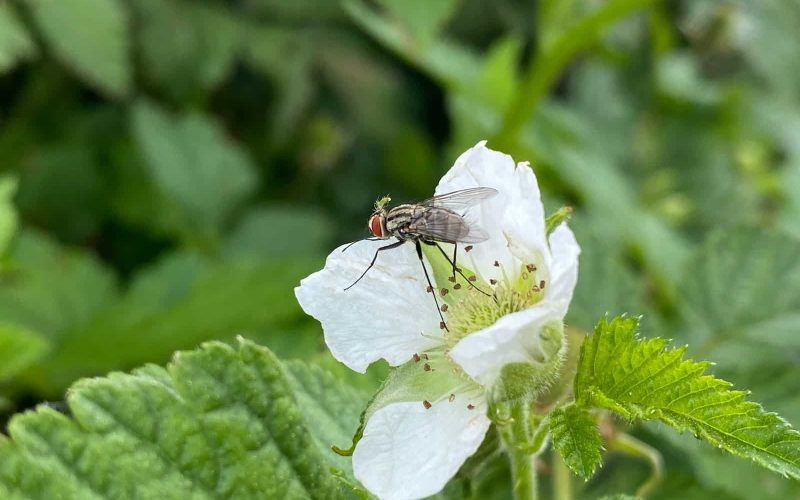There are two main types of flies in the garden that can make your life rather difficult.
Those are buzzing around you and laying eggs on your plants and fruit.
Therefore, here’s what you need to know about the different types of flies in the garden.
And how to eliminate them in the most environmentally friendly way possible!
Types of Flies In the Garden
1. Robber Fly
Robber flies are a type of fly that generally feeds on nectar, as well as other small insects. They have been known to feed on larger prey if they cannot find anything smaller.
They are often considered beneficial or harmless because they help control other insect populations.
Also, Robber flies can be identified by their large size with an elongated body shape and wingspan. They also have a noticeable bulge that houses their eye structure near their head.
2. Tachinid Fly
Tachinid flies are one of the most common types of flies in the garden that invade gardens.
These flies can be recognized by their shiny, black bodies with long antennae. Tachinid fly larvae have a white body with a brown head.
Therefore, they are usually found on plants eating all parts of the plant, especially leaves and flowers.
Tachinid fly larvae burrow into stems, which can cause young plants to wilt or die prematurely.
Adult tachinid flies do not bite or attack people, but they do lay eggs around your home, which will hatch into maggots that live in garbage cans, compost piles, manure piles, rotting piles of fruit, etc.
Infesting these places with disease-causing organisms like Salmonella and other germs.
3. Long-Legged Fly
The long-legged fly is one of the most common types of flies in the garden.
This fly lays eggs on decomposing organic matter like animal carcasses or old, rotting plants. The female will return to lay her eggs again on this decomposing matter.
Also, these flies are often attracted to gardens because they feed off decaying plant material, which makes up a large part of a garden’s ecosystem.
As a result, these types of flies in the garden can be difficult to get rid of.
4. Syrphid (Or Hover) Fly
Syrphid flies are some of the most common pest insects found in gardens. They feed on nectar, pollen, honeydew, fungi, algae, and other organic substances.
They can often be seen hovering around plants or crawling over a surface.
Moreso, Syrphid flies lay eggs on any moist surface near a food source, such as fresh manure or garbage piles.
The larvae that hatch from these eggs are typically predacious maggots that feed on decaying matter.
Therefore, keeping your garden clean and free from any rotting matter is very important.
So that syrphid fly populations don’t have an opportunity to grow out of control. If you notice maggots feeding on your plants, it’s time for action!
5. Aphid Predatory Midge
Aphids are small sap-sucking insects and one of the common types of flies in the garden.
They feed on plant sap, leading to stunted growth, yellowing, wilting, and death of some plant tissues. Aphids may also carry diseases transmitted to plants by feeding on them.
However, an aphid predatory midge is a tiny fly that preys on aphids. For this fly to work effectively, it needs a high density of aphids.
Because it does not have a long lifespan, only about one day, it relies on eating much prey during its short life span.
Therefore, the best time for these midges to be released is when there is a heavy infestation of aphids.
Or when you have an early warning sign such as white sticky honeydew deposits or curled leaves.
6. Flesh Fly
If you’ve ever been annoyed by flies buzzing around your head, then you know how nuisance these pests can be. But did you know that there are several different types of flies in the garden?
Therefore, the most common type of fly found in gardens is a flesh fly, also known as a cluster fly.
Because it likes to breed close together, these big black flies have long antennae and hairy bodies that lay eggs on carrion.
If you have some dead animals nearby, this could be your problem! If not, there’s still hope for relief.
One thing that can help is using insecticides, specifically ones with permethrin or pyrethrum, to kill the adults.
7. Green Bottle Fly
The aphid predatory midge is a small, dark brown fly that eats aphids. It lays its eggs on plants or soil near where aphids are present. The eggs hatch into larvae that eat the aphids.
Also, this type of fly cannot be attracted by placing out food sources as it feeds on nectar.
This makes it much less likely for this type of fly to become a pest problem than other flies. When their prey becomes scarce, these midges will move onto other plants for food.
Moreover, they can consume many other insect types besides just aphids.
So they will be an asset in your garden if you have any issues with pests like caterpillars or whiteflies.
8. House Fly
House Flies are usually a non-biting nuisance and also one of the types of flies in the garden.
They can be found around human habitation and feed on any food, from garbage to fruit juice.
House Flies can transmit many diseases, including typhoid fever, dysentery, cholera, anthrax, yellow fever, and bubonic plague.
Therefore, the best way to deal with House Flies is by using a fly swatter. Or by setting out sticky traps to trap the fly when it lands on the surface.
9. Deer Fly
The Deer Fly is a large fly typically found in rural areas. They feed on mammals such as deer and sheep. It is not known for biting humans but can do so if provoked.
10. Black Garbage Fly
The black garbage fly is one of the common types of flies in the garden that feeds on organic matter, such as fruit, vegetables, dairy products, and decomposing garbage.
They are one of the most commonly found household flies.
However, these flies usually enter through open doors or windows but can also be found near piles of composting materials.
These insects lay eggs on food items that are about to spoil; this causes a foul odor. The eggs hatch into maggots which feed on decaying matter.
11. False Stable Fly
The False Stable Fly (Musca domestica) is a pest that was accidentally introduced into North America.
It prefers to inhabit cool, damp places such as barns and houses. These small, brown, or tan flies have short wings and resemble houseflies in shape.
Moreso, they can be found hovering around garbage cans, decaying vegetation, manure piles, and warm, humid areas such as bathrooms.
The larvae are found in moist soil, feeding on organic materials, such as plant roots, animal dung, or rotting fruit.
Also, adults are weak fliers that prefer living outdoors. But will readily enter buildings for shelter during cold winter months.
This fly is considered a nuisance pest but does not bite humans or animals.
12. Fruit Fly
Fruit flies are small, soft-bodied insects that feed by sucking plant sap. The aphid predatory midge is a tiny winged insect that feeds on aphids.
This fly’s larva can consume as many as 50 to 100 aphids a day before they pupate into adults.
Therefore, these will be ready to lay their eggs within 24 hours after emerging from the larvae stage.
So it’s important for homeowners with an infestation of aphids not only to remove these pests. But also kill off survivors before they have time to lay more eggs.
Lastly, when looking for these flies, it is important for homeowners not just to look at plants.
You might find an infestation, but also inspect nearby vegetation or bushes where an infestation may have spread.
Ways to Get Rid of Flies in the Garden
There are many types of flies in the garden, but getting rid of them is not difficult. There are a few different methods for getting rid of these pesky bugs.
However, put up fly paper strips near fruit trees, bushes, or other plants that attract the insects. The strip will have a sticky substance, so when flies land on it, they will become stuck.
Flies will soon die from exhaustion as they struggle with their wings stuck against the surface.
Although this method has been used for many years and is very effective. Use vinegar instead of soap or water to clean dirty areas.
Where you suspect there may be some insect infestation, such as in containers and pots around your house.
Moreso, vinegar is an all-natural product that will kill off any unwanted guests lurking in the dirt.
Purchase some mason jar traps with holes cut out at various heights. Allowing smaller flies to enter while larger ones cannot.
Also, when these traps fill with captured pests, dump them into a container filled with cold water and detergent.
Then spray the outside of the jar with cooking oil to ensure no more entries.
Moreover, consider using an old-fashioned fly swatter or wet towel if you’re dealing with just one or two flying pests.
You can also try lighting a candle nearby if you notice flies gathering nearby since the flame will often ward them away.
Likewise, a small amount of liquid dish soap mixed with lemon juice and hot water makes a good homemade pesticide. Fill up one liter-sized bottle three-quarters of the way full with hot water.
Lastly, add ten drops of lemon juice (or orange juice). Stir in five teaspoons of dish soap, cap tightly, and shake well before use.
To apply, pour onto a sponge and scrub over surfaces like countertops and tables where they fly congregate.
Conclusion
Most gardeners dread dealing with flies in their yards; you are no exception.
But knowing what types of flies they are and how to get rid of them. It may make dealing with them easier.
Moreso, read on to learn about some common types of flies in the garden. And how to get rid of them to enjoy your garden to the fullest!








